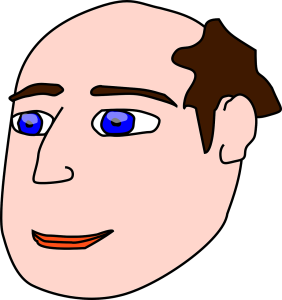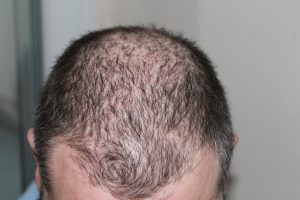
Alopecia is an umbrella term used to describe different types of hair loss, with many potential causes and treatments. It affects both men and women and can have a major impact on a person’s self-esteem and quality of life.
To begin, we need to understand what alopecia is and how it differs from other types of hair loss. Alopecia is a broad term that covers any kind of hair loss, from genetic or hormonal causes to certain medical conditions. It can involve partial or complete loss of hair, either on the scalp or other parts of the body. It can affect both men and women and can be temporary or permanent.
Types of Alopecia
The most common type of alopecia is androgenetic alopecia, or male and female pattern baldness. This type of alopecia is caused by a combination of genetic and hormonal factors. The hair follicles become progressively smaller leading to thinning and eventually balding. This type of alopecia is most common in men, however, women can also experience it.
Alopecia areata is another common form of alopecia. This form of alopecia causes patches of baldness to appear on the scalp or other parts of the body. In some cases, the condition may cause complete baldness and can be permanent. Alopecia areata is thought to be caused by an autoimmune disorder and can be triggered by certain health conditions, such as stress, infection, or hormonal imbalances.
Traction alopecia is a type of alopecia caused by pulling or tension on the hair follicles. This type of alopecia is often seen in people who frequently style their hair in tight ponytails, braids, or weaves. It can also be caused by the use of chemical treatments, such as dyes and relaxers. Traction alopecia can be reversed with proper care and treatment.
Scarring alopecia is a type of alopecia caused by an underlying disease or condition. In these cases, the scarring caused by the underlying condition can block the hair follicles, causing them to stop producing new hair. Scarring alopecia can be the result of a variety of conditions and diseases, such as lupus, lichen planopilaris, or frontal fibrosing alopecia.
Finally, telogen effluvium is a type of alopecia triggered by an underlying health condition or event. This type of alopecia causes the hair follicles to prematurely enter the resting phase of the hair growth cycle, causing them to stop producing new hair. Common triggers of telogen effluvium include stress, infection, childbirth, or certain medications.
Causes of Alopecia
To understand the causes of alopecia, it is important to first understand the anatomy of the scalp, follicles, and the physiology of the hair growth cycle.
The scalp consists of several layers. The outer layer is called the epidermis and underneath that is the dermis. Within the dermis, there are several hair follicles. Each follicle contains a single strand of hair that is connected to a sebaceous gland and is nourished by a network of capillaries. The hair follicles are responsible for the production of new hair and the growth cycle of existing hair.
Hair typically grows in three stages – the anagen phase, the catagen phase, and the telogen phase. The anagen phase is the longest stage and involves the growth of new hair. During this phase, cells in the follicle divide rapidly and new hair is produced. This phase can last up to 8 years. The catagen phase is the shortest phase and is a transitional stage in which the hair stops growing and the follicle begins to shrink. This lasts for about 2-3 weeks. In the telogen phase, the hair follicles are in a resting stage and new hair is not produced.
Alopecia is a result of disruption of the normal hair growth cycle. There are several potential causes of alopecia, including genetic predisposition, hormonal imbalances, and certain medical conditions.
Genetic predisposition is one of the most common causes of alopecia. If someone in your family has had alopecia, you may be more likely to develop it. Alopecia can also be caused by a hormonal imbalance, such as with menopause, pregnancy, or certain medications. In addition, certain medical conditions can disrupt the hair growth cycle and lead to alopecia, such as thyroid disease, autoimmune disorders, and iron deficiencies.
Certain lifestyle factors, such as stress, poor nutrition, and inadequate sleep, can also contribute to alopecia. Stress, in particular, can disrupt the functioning of the hair follicles, resulting in thinning hair or even baldness. In addition, certain hairstyles, such as tight braids and cornrows, can cause traction alopecia, which is a form of alopecia caused by excessive tension on the hair follicles.
There is one more cause of alopecia that you should be aware of – alopecia areata. Alopecia areata is an autoimmune disorder in which the body’s immune system mistakenly attacks the hair follicles. This leads to sudden hair loss on the scalp and other areas of the body.

Symptoms of Alopecia
The most common symptoms of alopecia are thinning or bald patches in the scalp, eyebrows, beard, or other areas of the body where hair typically grows. The patches can range from just a few hairs to complete baldness. There may be a gradual onset of symptoms or a sudden appearance of patches. It is also possible for someone to experience the “exclamation mark” sign, which is when a single hair falls out from a larger patch of hair.
In addition to bald patches, alopecia can also cause itching and burning of the scalp. This is caused by the body’s immune system mistakenly attacking the hair follicles. This can lead to mild discomfort or even pain in some cases.
It is important to note that alopecia does not always cause visible symptoms. For some people, their hair loss is silent and they may not even realize they have alopecia. This is why it is important to visit a doctor if you are experiencing any unusual hair loss or other symptoms.
Alopecia can also cause psychological distress. Hair is a major part of how people perceive themselves and their identity. Losing hair can affect one’s self-esteem and lead to depression, anxiety, or other mental health issues. If you or someone you know is struggling with the psychological consequences of alopecia, it is important to seek help from a mental health professional.
Diagnosis of Alopecia
The diagnosis of alopecia begins with a physical examination. During the physical exam, a doctor will look for signs of hair loss, such as bald patches or thinning hair. They may also look for other clues, such as patches of redness or scaling on the scalp, or inflamed follicles.
In addition to the physical exam, they may order a series of tests to further evaluate the condition. These tests may include a scalp biopsy, blood tests, or imaging tests such as a CT scan or MRI.
The scalp biopsy is the most commonly used test for diagnosing alopecia. During the biopsy, a small sample of scalp tissue will be removed and examined under a microscope to look for signs of inflammation, scarring, or other abnormalities.
Blood tests are used to rule out other potential causes of hair loss, such as thyroid disorders or anemia. Imaging tests may be used to look for any underlying abnormalities, such as tumors or cysts.
Prevention of Alopecia
The first step in preventing alopecia is to maintain a healthy diet. Eating a balanced diet that is rich in vitamins and minerals, such as zinc and iron, is essential for healthy hair growth. A diet that is low in processed and refined foods and high in fruits and vegetables, lean proteins, and healthy fats can help promote healthy hair growth. Additionally, drinking plenty of water to stay hydrated and avoiding excessive amounts of stress can also help reduce the risk of alopecia.
Another way to prevent alopecia is to practice good hair care. This includes avoiding tight hairstyles and over-styling, as these can cause unnecessary strain and breakage of the hair follicles. Avoiding chemical treatments, such as relaxers, perms, and dyes, can also help prevent further damage to the hair. Additionally, using high-quality shampoos and conditioners that are specifically designed for your hair type can help maintain healthy hair growth.
It’s important to be aware of any triggers that may cause a flare-up of alopecia. These triggers can include stress, a new medication, an illness, hormonal changes, or even an allergic reaction to a product or food. If you notice any sudden changes in your hair pattern, it’s important to speak with your doctor to help identify any potential triggers. Once you identify a trigger, it’s important to avoid it to minimize further hair loss.
Although there is no known cure for alopecia, understanding the causes and taking steps to prevent it can help minimize further hair loss.
Treatment of Alopecia
Treatment options for alopecia depend on the severity and type of alopecia. For mild cases, topical treatments such as minoxidil and corticosteroids can be helpful in stimulating hair growth. In more severe cases, corticosteroids or immunosuppressant medications may be prescribed to stop the hair loss.
In addition to medication, there are a number of lifestyle changes that can be made to help reduce the severity of alopecia. Stress management techniques such as yoga, meditation, and deep breathing can help to reduce stress levels and improve overall health. Eating a healthy, balanced diet and avoiding processed foods can also help to reduce inflammation and support healthy hair growth.
There are also a number of alternative treatments available for alopecia. These treatments include light therapy, acupuncture, and herbal remedies. Many of these treatments have not been proven to work, so it is important to talk to a doctor before trying them.
Finally, hairpieces and wigs are an option for those with alopecia. Wigs can be made from synthetic or natural hair, and come in a wide variety of styles. Hairpieces are a less expensive option, and can be made from human hair or synthetic materials.
No matter what type of alopecia you have, there are treatments available that can help you cope and improve your quality of life. Talk to your doctor about your options, and find a treatment plan that works for you.